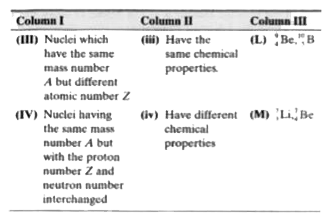Complete Solutions to PRACTICE QUESTIONS(Matrix - Match) of chapter THE NUCLEUS of Class 12 book with complete answers and questions
| Class 12 | PHYSICS |
| Chapter | THE NUCLEUS |
| RESNICK AND HALLIDAY | PRACTICE QUESTIONS(Matrix - Match) |
| Number Of Questions | 14 |
| Academic Year | 2023-24 |
Match the statements in Column I labelled as a,b,c, and d with those in Column II labelled as p,q,r, and s. Any given statement in column I can have correct matching with one or more statements in Column II

View SolutionSymbol Q stands for energy released

View SolutionIn each question, there is a table having 3 columns and 4 rows. Based on the table, there are 3 questions. Each question has 4 options a,b,c and d ONLY ONE of these four options is correct.
In the given table, Column I shows different types of nuclei, Column II shows their characteristics and Column III shows the example of different types of nuclei.


Determine the characteristics of isobars.
View SolutionIn each question, there is a table having 3 columns and 4 rows. Based on the table, there are 3 questions. Each question has 4 options a,b,c and d ONLY ONE of these four options is correct.
In the given table, Column I shows different types of nuclei, Column II shows their characteristics and Column III shows the example of different types of nuclei.


Determine the characteristics of mirror nuclei.
View SolutionIn each question, there is a table having 3 columns and 4 rows. Based on the table, there are 3 questions. Each question has 4 options a,b,c and d ONLY ONE of these four options is correct.
In the given table, Column I shows different types of nuclei, Column II shows their characteristics and Column III shows the example of different types of nuclei.


Determine the characteristics of isotones.
View SolutionIn the given table, column I shows the different types of decays in nuclear fission, collumn II show the change in the element which undergoes decay and Column III shows properties of different types of decays.

What are the characteristics of the below nuclear equation?
`""_(Z)^(A)X`(mother nucleus) `to""_(Z-2)^(A-4)Y`(daughter nucleus) `+""_(2)^(4)He`
View SolutionIn the given table, column I shows the different types of decays in nuclear fission, collumn II show the change in the element which undergoes decay and Column III shows properties of different types of decays.

What are the characteristics of the below nuclear equation?
`""_(z)^(A)X` (mother nucleus) `""_(Z+1)^(A)Y` (daughter nucleus)`+""_(-1)^(0)e`
View SolutionIn the given table, column I shows the different types of decays in nuclear fission, collumn II show the change in the element which undergoes decay and Column III shows properties of different types of decays.

What are the characteristics of the below nuclear equation?
`""_(Z)^(A)X*` (mother nucleus)`to""_(Z)^(A)Y` (daughter nucleus ) `+hf`
View SolutionThere are different types of radioactive series that radioactivie decay follows. In the given table, Column I shows the end or stable nuclei which any one of the radioactive series produces, Column II shows the mass number of different tpes of ratioactive series and Column III shows different values of n different radioactive sereis.

Determine the characteristics of thorium.
View SolutionThere are different types of radioactive series that radioactivie decay follows. In the given table, Column I shows the end or stable nuclei which any one of the radioactive series produces, Column II shows the mass number of different tpes of ratioactive series and Column III shows different values of n different radioactive sereis.

Determine the characteristics of neptunium.
View SolutionThere are different types of radioactive series that radioactivie decay follows. In the given table, Column I shows the end or stable nuclei which any one of the radioactive series produces, Column II shows the mass number of different tpes of ratioactive series and Column III shows different values of n different radioactive sereis.

Determine the characteristics of actinium.
View SolutionMany side particles are produced when radioactive decay takes place.In the given table, Column I shows the charge of the different side particles, Column II shows the mass and Column III shows the ionization power of these side particles.

What are the characteristics of `alpha`- particle?
View SolutionMany side particles are produced when radioactive decay takes place.In the given table, Column I shows the charge of the different side particles, Column II shows the mass and Column III shows the ionization power of these side particles.

What the characteristics of `beta`- particle?
View SolutionMany side particles are produced when radioactive decay takes place.In the given table, Column I shows the charge of the different side particles, Column II shows the mass and Column III shows the ionization power of these side particles.

What the characteristics of ``gamma` - particles?
View Solution
PRACTICE QUESTIONS(Matrix - Match) questions and complete solutions for chapter THE NUCLEUS of RESNICK AND HALLIDAY PHYSICS (HINGLISH) of Class 12